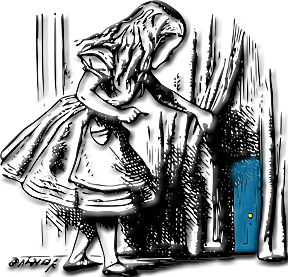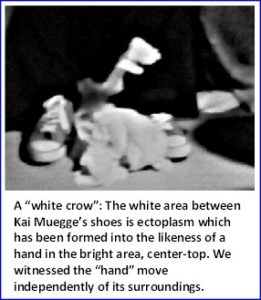 Also at atransc.org/peer-review-or-vetting/
Also at atransc.org/peer-review-or-vetting/
These practices are recommendations provided under the
Creative Commons Attribution-Noncommercial-Share Alike 3.0 Unported License
Sponsor
Initiated by Tom Butler.
Other editors include:
Abstract
It has been shown that expectations of the observer can have an influence on what that observer experiences. This observer effect is enhanced when the person insists that one thing is true despite possible evidence to the contrary. The consequence is the loss of an opportunity to experience genuine phenomena. The inevitable public denunciation of the phenomena and/or practitioner also harms the paranormalist community. This practice describes ways in which witnesses might avoid this problem by suspending judgment to leave time for additional information to become available.
Justification/Introduction
A well established scientific community helps us understand everyday experiences. In academia, a vast international library system helps researchers develop a consensus understanding of nature which leaves little doubt about how we should think of our ordinary experiences. However, when it comes to transcommunication and psi functioning, which are phenomena that are not recognized by the mainstream as either possible or real, there is virtually no academic or scientific community providing guidance to the paranormalist community. Organizations like Association TransCommunication help by reporting what others are saying. A
This Best Practice offers a consensus opinion of how to relate to paranormal phenomena. It purpose is to help develop a shared, informed point of view which would normally be developed by mainstream science and academia.
Practice
It helps to ask questions. It is important that people in our community feel free to do so. Perhaps our most effective defense against delusion is discernment through critical thinking, and that is accomplished by the free exchange of ideas. This is not to say that one opinion is as good as another. Reality behaves according to principles which are knowable. In fact, an opinion can only be a personal opinion if it is not supported by empirical evidence.
In this regard, it is important that people do not believe something is paranormal that is not. This has been a real problem in our community as mundane artifacts were widely seen as evidence but later understood for the mundane artifacts they really are. One form of photographic orbs comes to mind as a good example.
A Case Study
 A case study to illustrate this point is based on comments about darkroom séances reported in the ATransC NewsJournal. A person who was knowledgeable about EVP commented that “It seems fake to me.” He went on to say that “I believe there is a trap door or something like it. Notice that he’s behind the curtain for no real reason other than to shield eyes from whatever he’s doing. He may be an escape artist. He may have an associate sneak in from the floor or wall, etc. If he hid a small speaker in the wall outlet it could sound like this. He literally could have someone in another room speaking into a wireless mic and then it can be projected through the hidden speaker.”
A case study to illustrate this point is based on comments about darkroom séances reported in the ATransC NewsJournal. A person who was knowledgeable about EVP commented that “It seems fake to me.” He went on to say that “I believe there is a trap door or something like it. Notice that he’s behind the curtain for no real reason other than to shield eyes from whatever he’s doing. He may be an escape artist. He may have an associate sneak in from the floor or wall, etc. If he hid a small speaker in the wall outlet it could sound like this. He literally could have someone in another room speaking into a wireless mic and then it can be projected through the hidden speaker.”
This person also expressed a common complaint about pictures of ectoplasm: “The ectoplasm is most likely cotton gauze or some such item that he hides somewhere on his body. In the old days, they would hide it in their mouths then let it dribble out….”
The person is quite knowledgeable about some forms of these phenomena but appears to lack understanding of materialization mediumship. He also ignored the Butler’s first-person account of that included how they had thoroughly examined the room and that the circle had just moved into the rented house. The trap door explanation may sound reasonable. For people who assume trickery, it may even seem right. Once the trap door explanation is accepted, then all of the remaining proofs are easily ignored as more of the same trickery.
Most important, though, is the potential harm such unsubstantiated comments may have on the paranormalist community. This raises the question of, given that questioning experiences is important, how does one do so without seeming to be negative? The answer may be in the initial assumptions people have when they formulate their questions. There appear to be three basic first responses: the proof is faked, the proof is real and suspended judgment.
Assumption of Trickery
It is easy to assume an instance of phenomena is faked by saying, “There must be (any excuse you can imagine without bothering to produce supporting evidence).” The “There must have been a trap door” explanation is a good example.
The more positive response might be “How could that be?” which leaves open the possibility it might be real. Offered explanations about how something could have been faked are seldom supported by how the explanation could realistically explain the evidence.
The assumption of trickery became a form of group-think as people in England claiming to be Spiritualists went into something of a feeding frenzy as they proposed one unsupported trap door-like explanation after another for a well-known physical medium’s work.
Assumption of Fact
Assuming the validity of phenomena without question is equally damaging. Not knowing why a person believes something is true too easily leads to the appearance of faith-based systems of belief. The mainstream community will not take our frontier field of study seriously so long as vocal members of our community claim obviously mundane events as paranormal.
One of the most important factors keeping this community from maturing into the mainstream is the indiscriminate belief in evidence that is not actually evidential. It has prevented us from developing a common, credible point of view and assures that mainstream society will continue to accept the Skeptic’s view that we are delusional.
Suspended Judgment
Suspended judgment is the middle way in which experiences can be taken at face value, uncontaminated by assumptions based on belief rather than evidence. Most of the phenomena that are given a trapdoor-type explanation can be explained by more realistic hypotheses. For instance, one complaint from the English blog was that the order of events in the medium’s séances is always the same, however, in fact, virtually all of the mediums the Butlers have sat with express a similar need for consistent order of events.
A reasonable hypothesis is that the familiar order of events in a séance helps to entrain the medium’s mind, leading the medium to ever deeper levels of trance. The sameness is not proof the medium is in a deep trance. It is probably a necessary mechanism that makes the phenomena possible.
White Crows
Philosopher William James told us: “If you wish to upset the law that all crows are black, you must not seek to show that no crows are; it is enough if you prove one single crow to be white.”
It is not necessary to believe all that you experience. Instead, ask yourself if there is a single aspect of an experience that is convincingly paranormal. If so, then, based on your background understanding about things paranormal and how others have responded to the experience, you probably have reason to say that there may be truth in the experience. Say to yourself “I am not necessarily convinced about most aspects of this experience, but that one aspect is very convincing so I will keep the whole experience in my ‘wait and see folder’ as I seek more understanding.”
The white crow may take a while to show up. This is why suspended judgment is so appropriate. For instance, some darkroom mediums finish séances with their chairs moved from the cabinet to the open floor at the center of the room. The theory is that the entities use this movement to safely dissipate the accumulated energy, and of course, to provide something of an exclamation point to the demonstration.
 Moving the chair, and the usual rearranging of his clothes is a common demonstration of phenomenal control in David Thompson’s seances. It is difficult to put into an evidential perspective. However, at the end of the darkroom demonstration Stewart Alexander provided during the 2011 Stewart Alexander and Friends Conference, the Butler’s witnessed the glow tabs on Stewart’s knees passing by at eye level, less than a foot from their face. Others who were further around the circle, saw the tabs tilt dramatically as Stewart’s chair floated around the room. He had been partially awakened for the experience and complained something to the effect, “I really do not like this part.” Later, with the lights on, Stewart’s undershirt was found lying on the floor.
Moving the chair, and the usual rearranging of his clothes is a common demonstration of phenomenal control in David Thompson’s seances. It is difficult to put into an evidential perspective. However, at the end of the darkroom demonstration Stewart Alexander provided during the 2011 Stewart Alexander and Friends Conference, the Butler’s witnessed the glow tabs on Stewart’s knees passing by at eye level, less than a foot from their face. Others who were further around the circle, saw the tabs tilt dramatically as Stewart’s chair floated around the room. He had been partially awakened for the experience and complained something to the effect, “I really do not like this part.” Later, with the lights on, Stewart’s undershirt was found lying on the floor.
Events like the levitated chair are white crows that tend to give credibility to the rest of the demonstration. Certainly, not being able to explain what happened does not automatically lead to the assumption of trickery.
Unintended Consequences
Like super athletes, physical mediums are born with latent ability that seldom becomes evident without years of development. it is the personal cost of many years need for development and the risk of abuse from skeptics that paranormalists need to be mindful of. The attack by that English blogger became personal and was more debunking than an effort to understand. The blogger is responsible for what is on his website, so it must be assumed he supported the many naive comments from like-minded website visitors. It will probably not take very many attacks like that to deny the rest of us the chance to witness at least one white crow.
Example Application
This is important to give the reader an idea about how the practice applies. The example should show the potential problem of not following the practice.
Substantiating Material
Provide references supporting the practice if appropriate. Include substantiating evidence not identified by the references. Also when appropriate, include all statements indicating a recommended procedure should be supported by one or more of the following:
- Logical conclusions based on accepted social behavior, ethical standards and successful practices.
- Personal experience which is supported by at least three witnesses. (Their contact information should be available but not in the document).
- Research that has been published in a regularly published publication or on the Internet and that includes at a minimum, an explanation of the experimental protocol, results, involved researchers, date of the research and original purpose for the research.
References
![]()
